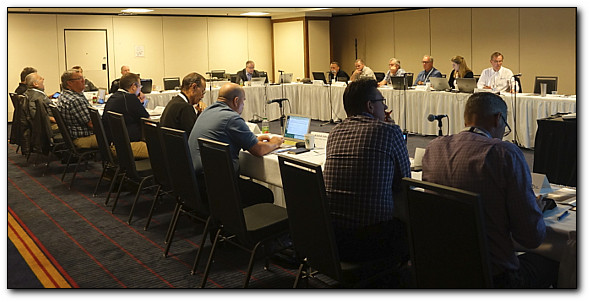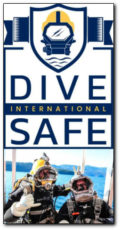Behind the Scenes: What It Takes to Approve a New Diving Standard
By CADC Admin ~ January 5th, 2025. Filed under: CADC MAG, Latest Diving News.
 In the commercial diving world, standards aren’t just paperwork – they’re lifelines. They are what stand between a diver and the myriad of risks that lurk below.
In the commercial diving world, standards aren’t just paperwork – they’re lifelines. They are what stand between a diver and the myriad of risks that lurk below.
But how does a diving standard actually come to be?
It’s easy to imagine a few folks in a boardroom, shaking hands and signing papers, but in reality, the journey from idea to official standard is long, winding, and full of obstacles. Anyone who’s ever been involved in this process knows it’s more like navigating a labyrinth of approvals, discussions, and – yes – more than a fair share of red tape.
The Canadian Standards Association (CSA) Dive Committee meetings in November recently gave new Canadian Association of Diving Contractors (CADC) members a glimpse into just how much bureaucratic weight can slow down a well-meaning initiative.
Here’s a behind-the-scenes look at what it really takes to get a diving standard approved, why it’s worth the hassle, and why it can sometimes feel like you’re swimming upstream.
Step one: identifying the need
It all starts with a need.
Maybe there’s a new technology in the field, a recent accident that exposed a safety gap, or a fresh environmental factor that diving operations need to account for. This need is often flagged by industry experts, safety consultants, or even directly from divers and operators experiencing issues in the field. It’s a grassroots beginning, but without this on-the-ground intel, we wouldn’t know where our standards might be falling short.
Once the need is identified, it’s flagged by CADC and others for review by CSA or similar regulatory body. Think of this as the stage where you bring your idea to the door, knock, and wait to see if they’ll answer. Often, it can take months – or even years – before a perceived gap becomes a priority on the standards agenda.
Step two: building the working groups
Once the need has been acknowledged, a working group of stakeholders is put together. This isn’t your average office committee. In the case of diving standards, you’re talking about a blend of experts, commercial divers, dive companies, engineers, manufacturers, medical professionals, regulatory representatives, training groups, and safety inspectors.
The goal? To gather every possible perspective to address the identified need comprehensively. But here’s where things start to get tricky.
Each member brings their expertise – as well as their biases. What a diver prioritizes might differ from what an engineer or regulator considers critical. Medical experts might push for more stringent health standards, while manufacturers focus on practicalities of equipment specs. It’s the classic case of too many cooks in the kitchen, and every cook thinks their ingredient is essential.
The result? Hours of debate, compromise, and more than often, sometimes a few heated arguments.
It’s in these meetings where red tape really starts to show. Every proposed change or addition has to be examined from every angle. What if this requirement adds prohibitive costs for contractors? Will it impact the timeline of a job? How do we ensure every diver in the country can meet this standard? And the ultimate question – how do we measure and enforce it? Every decision has ripple effects and the working group must weigh them all.
Step three: drafting the standard
Once the group reaches a tentative consensus, which is a Herculean task in itself, the drafting begins. This isn’t about just putting ideas down on paper; it’s about crafting clear, measurable language that leaves no room for ambiguity. The standard must be legally sound, scientifically accurate, and – ideally – practical to follow in the field. This can take several drafts, with members of the working group scrutinizing each word to ensure it covers the necessary ground without over-complicating things.
At this stage, the red tape turns technical. Every clause is analyzed for loopholes, conflicts with existing standards, and unintended consequences. Lawyers may step in to ensure the language is legally sound, and medical experts will review health guidelines. Engineers will go over every technical aspect to ensure the feasibility of equipment standards. It’s meticulous, mind-numbing work, and any misstep could lead to confusion – or worse, a dangerous gap in safety.
Step four: public review and industry feedback
Once the draft is finished, it goes out for public review. This is where industry professionals, diving contractors, and even the public get a chance to weigh in. It’s a critical part of the process, but it also introduces another layer of delays. Every comment or suggestion needs to be considered and responded to, often leading to more revisions.
During this stage, practical feedback from those who will actually use the standard – divers, supervisors, and contractors – is especially valuable. Sometimes suggestions will reveal unforeseen challenges in applying the standard to real-world scenarios. For example, a seemingly simple requirement might not work in remote or harsh environments where resources are limited. Each piece of feedback is carefully considered, and adjustments are made where needed.
Public review is a double-edged sword; it’s essential to catch potential oversights, but it can also bog down the process with contradictory suggestions, industry resistance, or calls for broader exemptions. Striking a balance is no easy feat.
Step five: approval and implementation
Once every hurdle has been cleared, the standard is finally submitted for formal approval by the CSA main Technical Committee, which can involve multiple rounds of voting and final reviews. Even at this stage, unexpected setbacks can arise. Maybe a government agency requests additional data, or a legal issue surface that needs ironing out. But if all goes well, the standard is finally approved and published.
Then, there’s the challenge of implementing the new standard. Training programs need to be updated, equipment may need upgrades, and divers and supervisors must adjust to new procedures. For those who’ve invested time and energy into the standard’s creation, this is the payoff. But for the industry, it’s the beginning of a learning curve, and sometimes a steep one.
Why bother with all this red tape?
If this sounds like a lot of work; it’s because it is. So, why do we go through this lengthy and bureaucratic process?
Simple: because lives are on the line. The stakes in commercial diving are high, and a poorly designed standard could mean the difference between life and death for a diver in a high-risk situation. It’s a serious commitment, and one that everyone involved takes personally.
It’s easy to get frustrated with the red tape and the endless meetings, but every hour of debate, every draft revision, and every piece of feedback brings us closer to a safer industry. These standards aren’t just words on a page – they’re the invisible supports that keep divers safe and bring them back to the surface, day after day.
So, the next time a new standard is released, take a moment to appreciate the behind-the-scenes work that went into it. It’s not glamorous and it’s rarely quick, but it’s always essential.
Doug Elsey is the Executive Director of the Canadian Association of Diving Contractors. He has been working in the commercial and military diving industry for more than 45 years.






